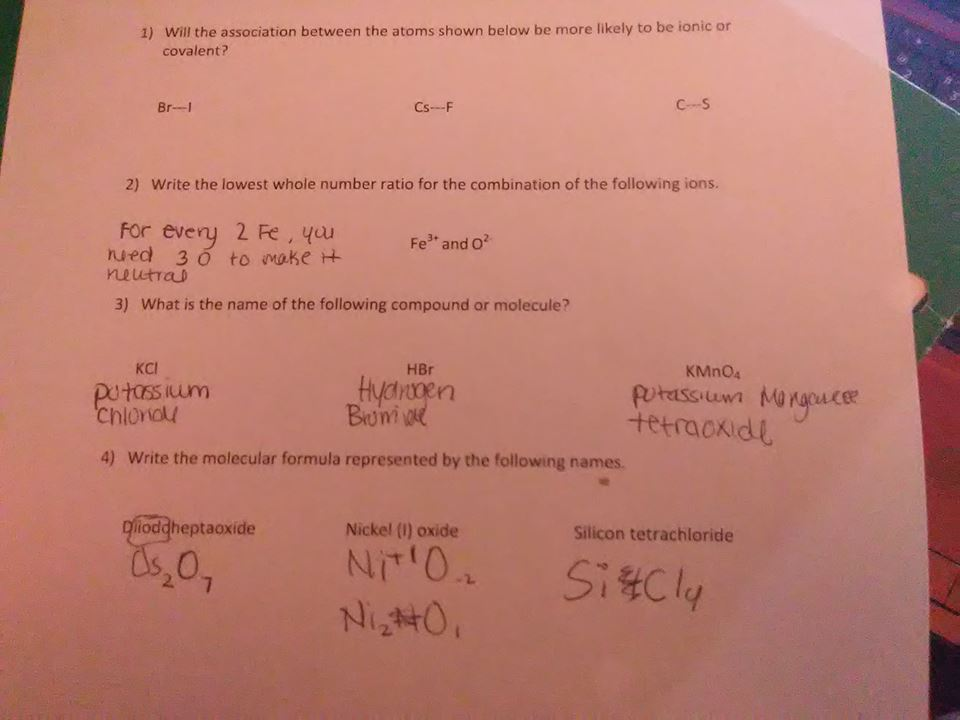IS this right?
Pyridoxine contains 11 hydrogen atoms, 8 carbon atoms, 3 oxygen atoms, and 1 nitrogen atom. What is the chemical formula for pyridoxine?
yeah that's right
the order is kind of dumb/arbitrary but I believe this would be PSBr3
Oh because Br has the r which makes it last ? :/
I just looked it up and apparently groups 13-15 get priority over other nonmetals tbh I've never heard of this rule
Calcium chloride contains only calcium and chlorine. What is the formula for this compound?
CaCl?
... well, according to the directions they gave you yes
INcoreect :/ It says this would not be neutral?
oh I misread the directions >_> the charges are Ca2+ and Cl- so you'd need 2 chlorine atoms per 1 calcium atom
CaCl2
yeah
for some reason I read it as 1 calcium atom and 1 chlorine atom
Could you explain this to me ? :/
*** hepta not septa ***
but what about the H2O
MgSO4 --> magnesium sulfate (the sulfate ion is the entire SO42-) ion 7H2O ---> heptahydrate
hydrate means water, so H2O --> ____ hydrate
oh okay
Don't you add up the molar masses from the periodic table?
what did I do wrong
I got confused by the 7h20 what do I do with the 7 when calculating the molar mass
The 7 applies to the whole water molecule (not the magnesium sulfate, just water) so you’d multiply the molar mass of water by 7
so 126.112 for the water molecule
246.5
only three sig figs, instead of rounding 246.466 to 246.5 you'd round down to 246
Okay I got that part. How do I determine the percent composition of the hydrate
What is the percent mass of magnesium sulfate in MgSO4⋅7H2O?
(molar mass of just the MgSO4 / total molar mass of the whole compound) * 100
to save some time, (120.37/246.466)*100
*now that I look at the other problem they actually wanted 4 sig figs for the molar mass of magnesium sulfate heptahydrate whoops*
I did 4 sig figs lol
If 28.0 g of MgSO4⋅7H2O is thoroughly heated, what mass of anhydrous magnesium sulfate will remain?
whatever percent you got from before * 28
Okay so do I subtract 28 from 126.112
hm, not quite, we calculated what percent of the whole compound is the magnesium sulfate part so you'd just multiply (120.37/246.466) * 28
13.67
yeah that's what i got too
so if a certain number of grams is being heated or whatever and I want to calculate the remaining I would just multiply it?
and would this be g/mol
sort of like, we calculated that MgSO4 makes up like 48% or whatever of the entire compound MgSO4 * 7H2O this proportion remains the same regardless of how much MgSO4 * 7H2O there is so in our example problem, there is 28.0g of MgSO4 * H2SO4 so 48% times 28.0 gives the amount of MgSO4, as desired
this particular problem is asking for mass, so g, not g/mol
Enter the formula for the compound formed between potassium and sulfur.
K2S
yeah that should be it
How many covalent bonds does carbon form if each of its unpaired electrons participate in one bond?
COuld you explain how I would do this problem
carbon is group 4A ---> 4 unpaired electrons ---> "each unpaired electron gets 1 bond" --> 4 bonds
so for oxygen it would be 6?
oh wait it would be 2?
hm, oxygen is a special case, it only gets 2
nitrogen= 5
is it basically imagining the lewis dot structure and imagining how many unpaired cases there would be
so nitrogen is 1?
oh, now I remember since oxygen has 6 VElectrons it takes 2 extra for bonding, thereby making 2 bonds since nitrogen has 5 valence electrons it takes 3 for bonding, thereby making 3 bonds
|dw:1539579970661:dw|
would this relate to electron configuration
i'm sorry im just trying to make connections because I just don't get it :/
oh by bonding you mean to make it a full shell which is 8?
yeah
so hydrogen would be 7
hydrogen is a special case, it doesn't follow the octet rule and only takes 1 bond
my explanations might not be the greatest, I just know from memory what they're supposed to be
No don't worry about it . i just like to go even deeper just so i am fully grasping the concept.
to be more specific hydrogen only has 1 electron normally, it doesn't fill up the second subshell which would have 8
hm, the three pairs in between are the bonding pairs and the two pairs on the outside are the lone pairs making C false between A and B I feel like both could work but I'm leaning towards A because it's a triple bond not three separate covalent bonds
lemme double check
oh b?
yeah between a and b for me too :/
double checked with a friend and they say A as well
okay wasb wrong or was a just the best answer
"three single covalent bonds" technically this is a triple bond, which is counted as one bond not three
just need you to look this over if you could
1) metal + nonmetal or metal + metal --> ionic nonmetal + nonmetal --> covalent
2) you're on the right track just write out the ratio 2:3
3) MnO4 gets a special name permanganate so KMnO4 ---> potassium permanganate
covalent ionic covalent
for 1
yeah that's what i got too
and then #4
4a) I'm not 100% sure but diiodd is probably iodine not osmium I2O7?
other ones look fine
compound nitrogen monoxide?
NO
yup
Join our real-time social learning platform and learn together with your friends!


.png)
.png)
.png)
.png)
